Check out our latest blog posts!
Learn how to improve your skill set or discover the latest news in the grooming industry.

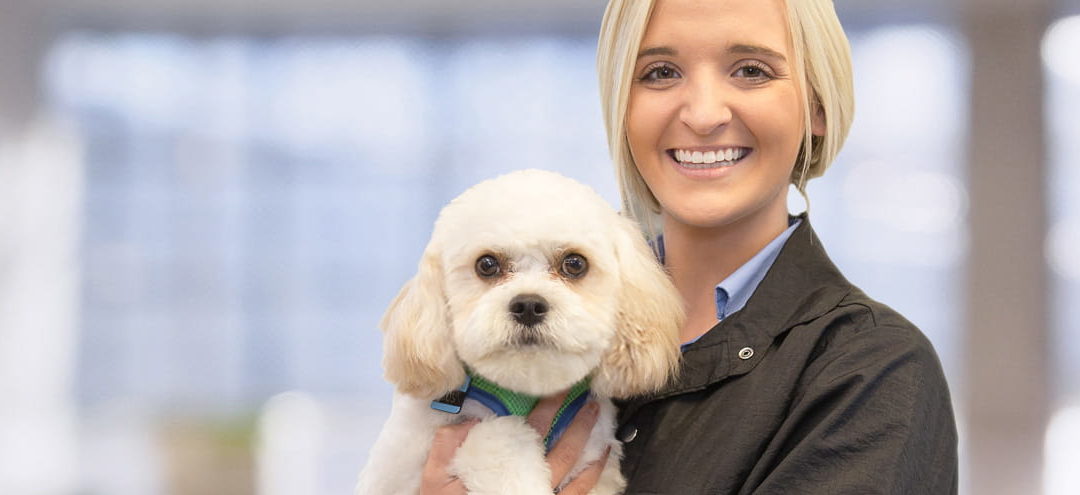
Check out our latest blog posts!
Learn how to improve your skill set or discover the latest news in the grooming industry.
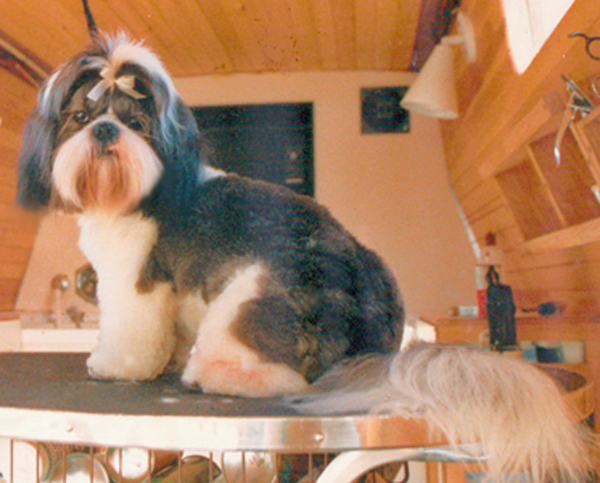
This is what I saw before I even BEGAN the grooming process on this little dog. I clearly saw the end results.
I feel fortunate because I have been asked to judge the Rags to Riches Grooming Competition hosted by PetGroomer.com and sponsored by Double K. Industries. This is an international online grooming competition in which photos are submitted of dramatic pet grooming makeovers. I have judged this competition many times in the past and always look forward to this assignment. It always amazes me what a skilled pet stylist can do with a dirty, overgrown, and extremely matted dog.
You know the scenario – the client walks in with a dog that is in such foul shape, you hardly know which end is the front or the rear of the dog. The dog is filthy. Its coat is extremely overgrown. It’s packed with dead undercoat and/or mats and tangles. Or worse yet, the coat is in dreadlocks. The simple solution is to just shave it off. We can all envision a clean – but naked pet. Sometimes that’s the best option.
However, the dogs that really capture my eye are not the shave-offs. An experienced pet stylist with imagination can see the end result before they even put their hands on the dog.
They can see the end result of a beautifully groomed pet before they even begin.
Begin with the end in mind.
I can almost guarantee that every past winner of the Rags to Riches Grooming Contest uses this technique. But if you are experienced, I bet you do this in your salon every day too.
The Rags to Riches Grooming Competition takes this to the extreme, but this technique can work with anything. Personally, I’ve used this technique with great success in many areas of my life, growing my businesses and my grooming career.
I first started using this principle when I read Dr. Covey’s book, 7 Habits of Highly Effective People over 20 years ago. Since then, there has been a wealth of material written about how to use this principle with great success.
When it comes to grooming and I see a dog come through the door, I instantly see the potential – the end result. Most of the time, I can’t even remember what the dog looked like before I started unless I have a photo to remind me!
When it came to contest grooming, I would study dogs I wanted mine to look like – the end result. I would take photos of top winning dogs. I read books on structure and movement so I could clearly visualize the underlying structure of a well put together pet. I would take photos of my dogs either wet or very short so I could clearly see THEIR structure. Then I would draw the trim I wanted to execute on top of their photo. This clearly allowed me to see the end before I even stepped foot into the contest ring or started scissoring.
If you have never studied this technique of goal setting and personal self-improvement, I highly suggest you spend some time learning it. It’s highly effective and very fun! And the best part – you can apply it to ANY aspect of your life.
Happy Trimming,
Melissa
WHAT THE JUDGES WILL LOOK FOR WHEN JUDGING:
There are five basic drying techniques that professionals use on pets. They are based on size, coat condition, coat type and personality of the pet. The coat type will often dictate which technique is used to produce the highest quality result. The different drying methods are:
Today I’m going to focus on the most important drying method to master: high-velocity drying techniques. Becoming proficient at this drying method will increase the quality of your grooms while decreasing the amount of time it takes to groom each dog. Bottom line: that’s money in your pocket!
High-Velocity Drying
About the High-Velocity Dryer
This drying method produces the fastest results with the highest quality if used correctly on any given coat type.
The pros of high-velocity drying include:
The negative points are:
As you can see, the positive points far outweigh the negative. Almost all of the negative points can be overcome through proper pet/dryer handling and correct technique.
Groomers, stylists, and bathers who regularly use this drying method should protect themselves by wearing facemasks, goggles and earplugs. These simple items minimize the amount of pet fur and dander that reaches the eyes and lungs, and helps deaden the noise to protect ears from long-term exposure. Pets will appreciate some type of ear protection too!
Using the High-Velocity Dryer
This method should be introduced slowly with any new pet or a puppy. Have the pet listen to the sound before the air is introduced. Help build its confidence. Once the pet seems calm, slowly and from a distance bring the air up around its feet or rear. Do this on a single speed, with no condenser cone. Once the pet accepts that, slowly bring the air in closer and move it up the body. Try not to let the air pass over the pet’s face or in its ears. As the pet grows more accepting, try adding the condenser cone, or, boost the dryer up to a second speed and then add the cone.
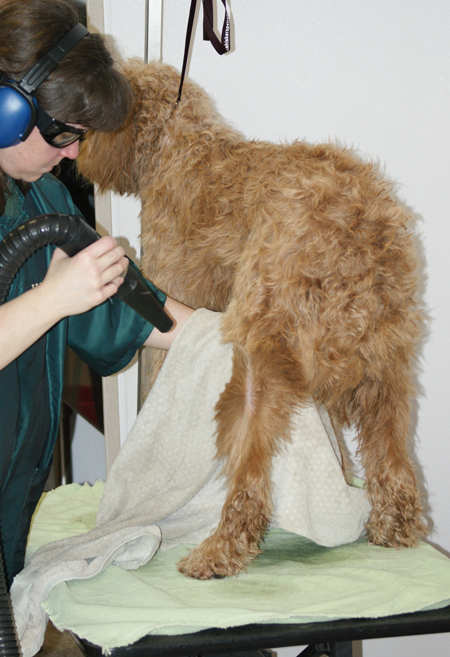 Move as rapidly as possible and work forward over the entire pet, excluding the head, watching for spray coming off the coat (the moisture you missed with the towel). Once there isn’t any more visible spray coming off the pet, return to your starting point. Holding a towel behind the spot you are working on can be helpful to reduce the amount of spray getting back on the coat.
Move as rapidly as possible and work forward over the entire pet, excluding the head, watching for spray coming off the coat (the moisture you missed with the towel). Once there isn’t any more visible spray coming off the pet, return to your starting point. Holding a towel behind the spot you are working on can be helpful to reduce the amount of spray getting back on the coat.
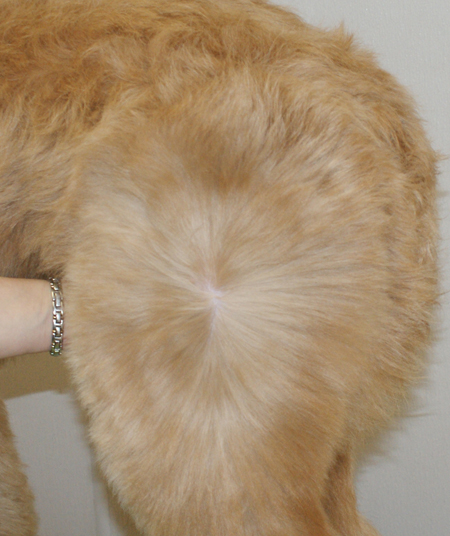
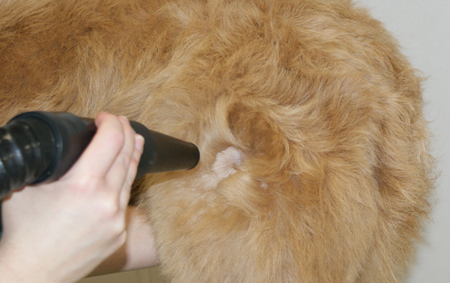 Next, focus on getting the pet dry and the coat straightened. Hold the dryer as close as possible to the skin without curling the coat onto itself, causing tangles. Rapidly move the air around in a small, confined space. Watch the area constantly. When you first start on a section, the coat will appear slightly clumped together. As the hair dries, it will separate and become very fine. This is your signal to move to another area.
Next, focus on getting the pet dry and the coat straightened. Hold the dryer as close as possible to the skin without curling the coat onto itself, causing tangles. Rapidly move the air around in a small, confined space. Watch the area constantly. When you first start on a section, the coat will appear slightly clumped together. As the hair dries, it will separate and become very fine. This is your signal to move to another area.
Leave the head, tail and ears until last. If the pet objects to having air blown around its face, change the direction of the air so that it does not blow over the face and ears. If the pet shows only mild objection, then hold its head for more control. If the problem continues, remove the cone to handle the neck and chest area.
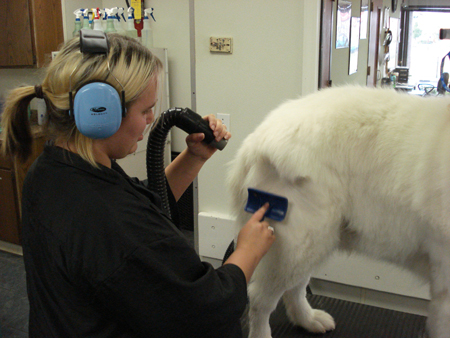 If the coat is slightly matted or the pet is shedding heavily, you will notice the matted hair form a kind of spidery web as the coat begins to dry. Guide the air just behind the webbed section to work it out. Use the condenser cone with as much air force as the pet will allow. You must watch this process constantly to be effective. If the pet will not allow a condenser cone, or if you have worked the loose coat or mat as far as it will go with the air, give the coat a “boost” with a brush and mild air flow. Normally, this will remove the rest of the loose coat with the least amount of wear and tear on you and the pet.
If the coat is slightly matted or the pet is shedding heavily, you will notice the matted hair form a kind of spidery web as the coat begins to dry. Guide the air just behind the webbed section to work it out. Use the condenser cone with as much air force as the pet will allow. You must watch this process constantly to be effective. If the pet will not allow a condenser cone, or if you have worked the loose coat or mat as far as it will go with the air, give the coat a “boost” with a brush and mild air flow. Normally, this will remove the rest of the loose coat with the least amount of wear and tear on you and the pet.
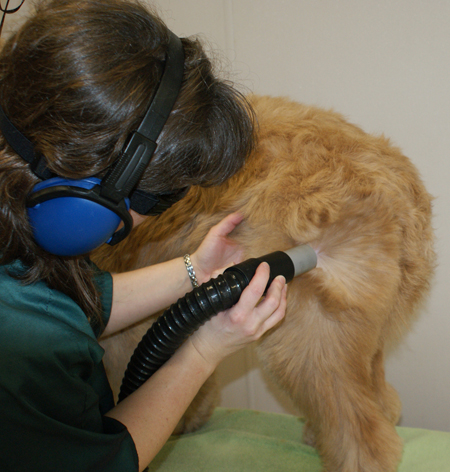 Now that the pet is dry primarily from the condenser cone work, remove the cone and hold the base of the hose right next to the skin. Most high-velocity dryers do not have a heating element, but once they have run for a few minutes, the air they produce will be warmer. Removing the condenser cone and placing the dryer hose right against the skin takes advantage of the optimum power of a high-velocity dryer to “set the coat.” Setting the coat means straightening each hair shaft. Plus, holding the warm air right next to the skin will remove any remaining dampness. Work over the entire dog using the same method as previously outlined, but now work very close to the skin.
Now that the pet is dry primarily from the condenser cone work, remove the cone and hold the base of the hose right next to the skin. Most high-velocity dryers do not have a heating element, but once they have run for a few minutes, the air they produce will be warmer. Removing the condenser cone and placing the dryer hose right against the skin takes advantage of the optimum power of a high-velocity dryer to “set the coat.” Setting the coat means straightening each hair shaft. Plus, holding the warm air right next to the skin will remove any remaining dampness. Work over the entire dog using the same method as previously outlined, but now work very close to the skin.
Finish the entire drying process at the head and ears. On coats where you want a full head shape, work from the base of the skull – the occiput – forward. If you want the coat to lay tight to the skull, blow the air back towards the rear of the dog.
If the pet is fidgety, grasp the ear at the base. This firm grip offers the most control and covers the ear canal. In most cases, a fidgety pet is objecting to the air going down into the ear canal. Don’t use a condenser cone for the head and face, but do keep the base of the hose right next to the skin for optimum speed and coat straightening.
Pets pre-clipped shorter than a #7 blade length before the bath will not need a high-velocity drying in the short areas. These areas will dry naturally as other coated areas are dried. Normally, a #7 blade length or shorter does not need straightening to yield the best results in the finish work.
Conclusion
It is important to master all drying skills. There are several drying methods and combinations to choose from, based on coat type, trim and pet tolerance. Incorrect techniques or careless attention to drying will waste more of a professional groomer’s time than almost anything else.
An active form of drying always will yield the best results. Having a beautifully clean and dried coat also will lessen the amount of time it takes to execute the final grooming procedures on a pet.
If at any point the pet objects or becomes difficult to handle, back down to the previous step that produced a positive result. If the pet severely objects to having its face dried, try placing cotton balls in the ears to reduce the air flow into the ears as well as the sound. Just don’t forget to remove the cotton balls.
Always remember, the pet takes its cue from you. Your confidence will communicate to the pet. Work gently, but firmly, using a minimal amount of verbal positive or negative reinforcement. Let your hands and eyes do the speaking for you.
The process outlined above may take just a few minutes or several, based upon the individual pet and your handling techniques. On occasion, a pet just will not accept high-velocity drying and another method will be necessary.
Once you have the pet’s cooperation, you can focus on the most effective way of using the high-velocity dryer on that pet’s individual coat type.
In trims that require a fluffy, smooth finish, you would begin at the base of the tail and blow the air forward, using a condenser cone. On many Terriers and sporting dogs, you want the coat to lay tight to the skin. With these breeds, start at the withers and work with the growth of the coat.
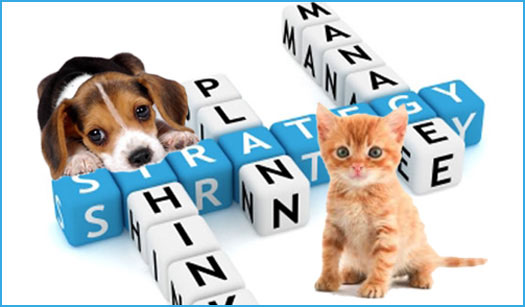
Are you tired of working for others? Are you ready to step out on your own? Do you dream of owning your own business? Yes?
Fabulous – but are your prepared to open you own place?
Did you know that almost 50% of all service based businesses fail within 5 years? Don’t become one of those statistics. You need a plan. You need a comprehensive business plan.
A business plan acts as a road map. It’s your compass so you don’t get lost along the way as you launch your new venture. Not creating a plan is one of the biggest mistakes you could make with your future. It would be like trying to drive from Michigan to California without a map. Or a GPS. You’re not going to get there very quickly if you do not have a clear plan.
A comprehensive plan contains a number of key factors about your new business. This is a list of items from a business template I personally use and recommend whenever I start a new venture. It’s from the Service Corps of Retired Executives (SCORE). It can be found on line.
I know – I know. Most new business owners are so anxious to get going – they neglect this critical planning stage. There is lots of money to be made and pets be groomed. You don’t need a ‘plan.’
Whoa there. Failing to plan is a plan to fail. Period.
Filling out the many details in your plan can be an overwhelming process. Many are so intimidated by the financial calculations; you want to skip that process all together. But don’t! If you are overly intimidated by sections of the plan, get help. All successful businesses have a team of people that have helped them succeed. Start building your team now.
Most people find it helpful to have the following experts on their team;
If you do not have these experts to assist you with your plans, there are other options. You can take business and accounting classes. Attend local business seminars or workshops. Or take business classes on line. Plus, there are great computer programs that can help you set up and run your business.
Other resources to help you write a business plan include books, colleges and universities that work with Small Business Development Centers and counselors and mentors at the Service Corps of Retired Executives (SCORE). They provide low-cost classes on how to write business plans that can be very reasonable.
Most new businesses need some type of funding. However, it is so economical to start a pet grooming business; many new business owners skip the financial section of the plan. Big mistake. Even if you do not need a lot of money to start your business, writing a plan will allow you to clearly identify if your idea will be strong right from the start. Without a plan, you leave far too many things to chance.
You definitely will need a plan if you are going to apply for a business loan, look for private investors, or have business partners. Even if you don’t need assistance with funding, you still need a plan. YOU and YOUR livelihood depend on it!
Before you even start to write your plan, get copies of loan applications used by banks, commercial finance companies, and government. These applications will give you a good idea of how much financial information you will need to include in the business plan.
A good business plan should provide a reader with a general idea of what a business owner is trying to accomplish. It should be well organized, neat, tidy, and easy to read. A reader should be able to get a good feel for what you want to accomplish within minutes of quickly flipping through the pages of the plan.
How long should your plan be? For a new start up grooming business, you plan can be 20 or 30 pages. You want to be concise and to the point. Long business plans are boring – and no one wants to spend time with a boring plan, including your potential funding resources! The text should be within one or two font families, making it very easy on the eyes to read. The text should be well-spaced. Bullet lists make it easy for the reader to get through a long list of details easily. Illustrations, samples of marketing materials, charts and simple spread sheets all bring the plan to life.
Just remember that the most important person for a business plan is YOU! By not working through the process of creating comprehensive business plan, chances are your business failing within a few years is greatly increased. Keep in mind, almost 50% of all new service businesses fail. Help yourself become successful by creating a plan for your new pet grooming business.

I’m so fortunate to live in a place I consider paradise. It’s a combination of woods, fields, orchards, and swamp. Here in West Michigan, we enjoy four seasons. (Okay, winter can drag on a bit too long some years) We’ve been on this large acreage for years.
In my down time, I love to take my dogs for runs, cut new trails, power walk, cross-country ski, snow shoe and horseback ride. I’ve been all over this property in the past 12 years. I know every inch — or so I thought…
A few weeks ago, I was out walking our property. It was one of those rare, gorgeous days in March. The sun was out and the temperatures were extremely mild. Nothing was green yet, but you knew it was coming.
I was Nordic power walking for exercise. I was approaching my one-hour mark but I was not ready to quit. I just crossed a stream and came to a fork in the trail. I was standing at my husband’s deer blind. Normally I hang a left and follow the trail through a field and ultimately back into the orchards towards the house.
But today was so pretty, I thought I’d test out a new path. My husband keeps a large swath brush-hogged for hunting next to one of the horse pastures. It looked like a perfect good-sized loop to explore.
I knew at the end of this open area, over in the corner, there is an old junk area. Almost every old farm has one of these on their land somewhere. We’re no exception.
As I approached the junk area, I looked through the underbrush. I thought to myself, “boy, there’s some big stuff back there — things I’ve never seen.” I needed to investigate. As I ducked under branches and wove my way back into the junkyard, I was surprised at how large the area actually was. There was A LOT of stuff back there!
The years have been slowly swallowing this area with underbrush. For most of the year, this area is so thick you couldn’t begin to see beyond 8 feet. However, on this day, the green foliage was not out yet. I had a clear view once I got back in there.
Wow. Here was this old Chevy truck. I’d never seen it before! How does something this large stay hidden from view? I have no idea what year this truck is. However, I swore I learned how to drive a stick-shift on an old farm truck just like this when I was in high school out west! I wonder what kind of stories this old truck could tell.
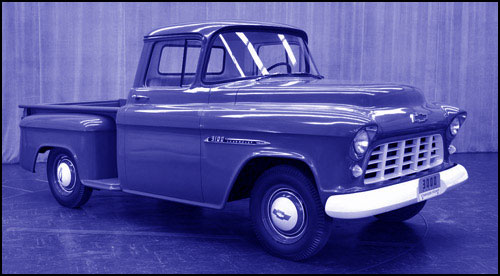
I’d been by this area 100s of times. This was the first time I’d ever noticed a virtual graveyard of large farm equipment and vehicles buried back behind the junk area. They’ve always been there — I just never noticed them before. The timing was just right today.
As I departed the area, in awe of what I just found, I thought; our careers are like that too. Information is presented to us all the time. But what do we picked up on? What do we notice? What do we put into use? It’s all in the timing.
Careers change. Life changes. Information that is available to you all the time will only register in your mind when the timing is right. Can you use this information to improve your life or your career? Will it enhance your job somehow?
When I first started attending grooming seminars and reading books, I was like a dry sponge. I soaked up so much information so fast. It was fun. It was exciting. But then it kind of leveled off. I wasn’t gathering nearly the amount of information I was early in my career.
As I gathered experience, I become more selective about what I retained. When I was first learning to groom, there are priorities I needed to focus on first. How to do you get a pet clean? How do you blow out the coat perfectly? How do you remove mats and shedding coat? How do you get a smooth clipper cut? I wasn’t ready to learn about breed profile trimming. I wasn’t ready to learn about balance and symmetry. I wasn’t ready to learn about the finer details of grooming. Running a business. Managing staff. Mastering marketing. But as I understood each new skill, I was ready to learn more. I was climbing that imaginary staircase, one step at a time.
I’ve been developing my career for over 35 years. Just like with finding that old truck, it was all in the timing. As my career has unfolded, I learn new things all the time. Most of the time, it’s nothing new or revolutionary. But it is to me. It’s fresh and new — to me. The timing was just right for me to apply this new tidbit of information.
Your career and personal development will be like that too. Never stop learning. Always be ready to gather new knowledge when the timing is right. You never know what you might discover.
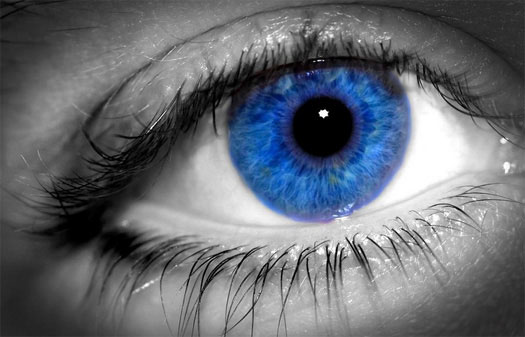
Sight is probably the most developed sense in humans. Next is hearing, followed by smell. When you’re client walks through the door of your business, what do they see, hear and smell?
What type of image you present to your customers? Do you project a professional image? Do you project an air of authority as the expert? Your clients and perspective clients gain confidence in your ability by the clues should give them through sight, sound and smell. Will you handle their dog with compassion? Will the pet be safe in your care? Will you be able to provide a quality haircut that they love? People will automatically question your ability to perform at a professional level if what they see, hear and smell are not up to their standards.
A busy pet care facility can be extremely hectic. Sometimes we get so lost in our daily tasks, we lose track of what our clients see, hear and smell as they walk through our doors. If you’re immersed in the chaos, your senses can become dulled. It’s time to pull back and take a good look at what makes a first impression to your customers.
In Judy Hudson’s Learn2GroomDogs.com video called “What I Know for Sure,” she shares a great story told by a very wise grandmother. She said. “It doesn’t cost a lot of money to be clean. It doesn’t cost a lot of money to be neat and tidy. It does take a little elbow grease.”
Take a good hard look at yourself. Take a good hard look at your support staff. Take a good hard look at your salon. What could be done to present a more professional image to your customers? If customers can’t trust you — they’re won’t be coming back to you.
Start with yourself first. Are you freshly showered? Is your deodorant working well? Is your hair neat and tidy? Is it clean? Is it styled? If it’s long, is it neatly tied back? What about your clothing? Are you neatly groomed yourself in hair repellent clothing? Is it wrinkle free? What about that sandwich at lunch? Is it still stuck between your teeth? If you’re not neatly groomed, what kind of message does that send to your customer? Ask same types of questions of your staff. What kind of image do they present?
What condition is your lobby in? Is it old and tired or bright and fresh? If you have retail, do you keep the stock freshly turned? How organized is your registration area? What about the front entrance of the shop? Is there fur and dust bunnies collecting not only on the floor – but on the pictures on the wall too? It’s amazing what fresh coat of paint can do combined with regular dusting and mopping. If you are mobile, when was the last time you washed the outside of your van?
What do your clients hear when they walk through the door or if the phone is set down without putting them officially on hold? Are you fighting to communicate with the customer over the sound of a vacuum or high velocity dryer? Or are yapping dogs making it so distracting you can barely converse with your client? Worse yet — is somebody in the back room screaming at a dog? Some of these sounds can be controlled — some are just the nature of the business. However, you do have options to minimize the offensive noises through organization and salon policies.
When your customers walk through the door, what do they smell? Wet dog? Urine? Feces? Cigarette smoke? Anything offensive? Bottom line, if a salon doesn’t smell pleasant — it’s dirty. Working with animals is great. But what a lot of people don’t realize when they get into the business, you need to spend a great deal of time cleaning up after our furry friends. I don’t care what kind of animal is — animals create a mess! Daily, weekly, monthly, quarterly, biannually, and annual cleaning duties all need to be addressed on a regular basis. Not only do you need to deal with all of those, but you’ll also need ongoing cleanup as your day progresses.
That’s just the nature of the beast. A little bit of awareness and a lot of elbow grease will keep your salon looking — and smelling – professional.
You can gain a great deal of trust by paying attention to first impressions. These first impressions are going to be highly influenced by; sight, sound and smell. Clients and prospective customers look clues about a service. If they don’t sense you have what it takes to provide a quality service and build their trust, they look to other grooming services that do have them. So provide clues that will keep customers returning.

I’m just like most of you. My first business was a mobile van. I was extremely successful. Within less than a year I needed a second van. I needed someone to run that unit. I didn’t want it complicated. I just needed help. I figured the easiest route to go was to find the person that could groom and send them out in a second rig. I didn’t need to file all that mumbo-jumbo with the government. Heck, this person was going to run solo — it was the perfect situation for an independent contractor. After all, everybody else was doing it!
Fast forward three years. I now had four rigs. I had hired an accountant. My accountant suggested I hire a CPA to do my taxes. Throughout the years I knew in my heart I was running close to the wire with my independent contractors. My father had been harping on me. My accountant was concerned. My new CPA really set me straight using a very effective tactic — fear.
If you work with independent contractors within your grooming organization, do you really know the current tax laws? The IRS is very strict with its rulings concerning employees vs. independent contractors. Being naïve is no excuse. If you are ever caught, it will be the IRS that makes the ruling on whether you actually have an employee or an independent contractor.
There are a number of different ways to get caught. It might be an audit of your business or one of your workers files an unemployment claim, a disgruntled worker simply turns you in are a few of the common ways but there are many more.
I know — I know. You can’t afford to hire employees. All those taxes you have to take out of the employee’s paycheck and all the taxes that you need to pay into the government both state and federal plus Social Security and Medicare for each employee. Whew – it’s a paperwork and budget nightmare.
But trust me, if you have your workers misclassified, you can’t afford not to have them as employees if that’s what they truly are. The IRS has no qualms about coming in, slapping you with heavy fines and penalties equal to the amount of all the back taxes owed plus all the interest on those back taxes. Plus, the IRS may turn you in to your state government as well. In one single sweep, your business and your livelihood can be destroyed.
Shortly after I switched from independent contractors to employees I started hearing real life horror stories from within our own industry. One of my personal idols virtually lost everything due to incorrectly filing with the IRS. They lost their business, their home, their personal relationship — everything. They confirmed the fear that placed into me by my CPA years before. The IRS will – and can – destroy your life if you do not play by their rules. The stories that were shared much later only reaffirmed I had made the right decision years before.
So here’s the scoop. The laws are complex, subjective, and inconsistently applied, but knowing the rules can keep you and your workers safe. So here they are, in a nutshell: Under United States common law, a worker is an employee if the person for whom he or she works has the right to direct and control the way he or she works, both as to the final result and as to the details of when, where, how, and in which sequence the work is to be done. It is the IRS’ view that the employer need not actually exercise control. It is sufficient that it has the right to do so.
Here’s a list of 20 questions the IRS uses to determine if a worker is an independent contractor or an employee. A ‘yes’ answer to any of the questions except #16 may indicate your worker is truly an employee. Take a look. Be honest with yourself — you can’t afford not to. (and yes did raise my grooming prices!)
IRS 20 Questions: Independent Contractor OR Employee
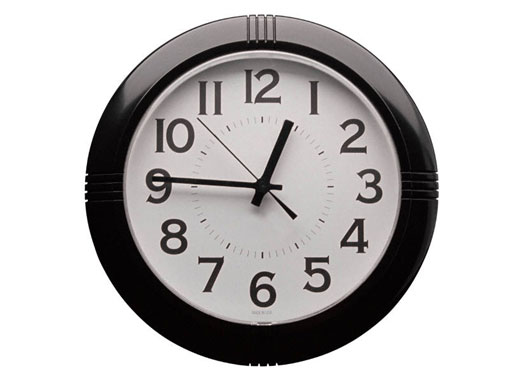 My husband Marc and I just did a private salon lesson on one of our recent road trips. We asked the salon owner what she wanted us to focus on during our time there so we could be better prepared. The request was simple. Speed.
My husband Marc and I just did a private salon lesson on one of our recent road trips. We asked the salon owner what she wanted us to focus on during our time there so we could be better prepared. The request was simple. Speed.
Most of her staff struggled to get even the simplest trims done in under an hour. Bath. Blow dry. Haircut. Even a basic #7F all trim on a smaller drop coated breed was daunting to some of them.
We walked in and saw a well-organized salon. It was bright. It was clean. The layout allowed for efficiency. The equipment was all top-notch. Hmmm, we wondered. Why was turning a small to mid-sized dog such a challenge for them?
Then it hit us. There were hardly any clocks visible. We only spotted one clock in the main room. A smaller digital wall clock set on military time. The owner of the salon was career military gal who is now retired. I understand why she opted for that style of time keeper. (And thank you Lori for your service to your country!) I’m just not so sure that style of time keeping is the right for a staff of non-military groomers. Plus, when I was across the room, I could barely read it clearly. The clock was just too small!
If you want to be a successful groomer that can pay their bills while bringing customers back again and again – you need to embrace time. Watch the time. Track the time. Race against the time. Everything we do with professional pet grooming involves time. You need to be highly aware of every hour, minute and second. Ideally, a professional groomer should be able to turn a small to medium size simple trim in an hour or less. That includes the bath, the dry, and the trim.
The first thing we suggested to this team was; GET CLOCKS! Nothing fancy, they just needed to be large enough to be easily seen across the room. The simpler, the better. Every room in the salon needed one hung on the wall. By having a clock in every room, it makes it easy for the groomers to track their own time with just a quick glance. But clocks aren’t enough. Every person working on the pets needs to have a watch on too.
For those individuals that are really looking to increase their speed, having a timer at their stations can be really beneficial. Before you can start timing yourself, it’s helpful to know what your starting point is.
Break the groom down into sections. Bathing. Drying. Clipping the body. Trimming the feet. Rounding the feet. Scissoring the legs. Styling the head. If you don’t know how long it takes you to do each one of these items, you’ll never be able to improve upon your ‘best time.’
And it’s far easier to break it down into segments than to look at the dog as a whole. After all, who doesn’t want the opportunity to win at even one or two smaller segments than to get frustrated when they don’t hit the time goal with the overall trim?
Once you know how long it takes you to do each segment — now you can set goals and objectives to beat your ‘best time.’ Push yourself. Make a game out of it. The clock will be your score-keeper. Each time you gain even a few seconds, you’ve won a mini victory! But you’ll never be able to do that unless you can easily watch the clock. Even with all the clock watching, always remember, speed and efficiency can never come at the sacrifice of quality or safety.

A well-made, brightly colored bow or bandanna is one of your best marketing tools. The eye is naturally attracted to bright colors. No matter how beautiful the grooming, a pet will attract attention faster if it is sporting a bright color.
Applying bows or bandannas as a finishing touch on a fabulous groom is a sure way to generate interest. Interest, that is, in you, the person who got that animal looking so fine in the first place.
The number one sales tool for any business is referrals from word of mouth advertising!
 I learned this when I was very young, with our family’s first dog. When we traveled, we’d send our Golden Retriever to a local kennel. Upon picking her up, she’d always be freshly bathed and wearing a simple piece of felt fabric attached to her collar in the form of a bow. The color would change with the seasons, but this simple bow was there every time.
I learned this when I was very young, with our family’s first dog. When we traveled, we’d send our Golden Retriever to a local kennel. Upon picking her up, she’d always be freshly bathed and wearing a simple piece of felt fabric attached to her collar in the form of a bow. The color would change with the seasons, but this simple bow was there every time.
In our small community, everyone walked their dogs. As we stopped and chatted, people always noticed the felt bow. That was the opening we needed to share the name of the kennel and how wonderful their services were. If that basic little bow was not there, the kennel name would never have been mentioned and a marketing opportunity missed.
I carried this lesson over into my grooming business. No dog ever stepped out of my salon or mobile van without a bright finishing touch. (Unless a client requested “No Bows.” But that didn’t happen very often.) The bows were always subtle and very tastefully made.
Successful people know paying attention to minor details is critical. Bows and finishing touches are part of the entire service package.
 Making attractive bows does require some finesse. It takes a bit of time to learn. But once you figure out a method that works well for you, you will be limited only by your own creative spirit and time.
Making attractive bows does require some finesse. It takes a bit of time to learn. But once you figure out a method that works well for you, you will be limited only by your own creative spirit and time.
Many professional groomers and stylists use down time to create bows. They use this time the same way that many people use knitting or crocheting to relax. However, if basic bow tying just isn’t for you, there are many companies that specialize in wonderful, ready-to-use bows. I encourage you to use them!
There are thousands of ways to market yourself as a professional pet groomer. The number one rule of any marketing campaign is to capture potential clients’ attention in a fun and tasteful way.
Choosing to accessorize a freshly groomed dog with a bow or bandana is a highly successful marketing opportunity. Adding a spark of color to a pet can be the perfect way to get owners talking about your pet service business.
Occupational athletes. That’s what my chiropractor is calling our profession of pet grooming. All those years of bending, lifting, hoisting, twisting, and reaching certainly takes a toll on the body!
And let’s not even talk about the repetitive motion stuff! Or where our hearing levels are at – what did you say? Have you ever thought about what our lungs look like? Yuck!
Yes! We definitely fit the bill of ‘occupational athletes’. We know many of our Learn2GroomDogs.com Training Partners have been afflicted with injuries or conditions that have really made their careers painful. And that includes me.
I was recently in such terrible pain that I could not move my arm. It came on suddenly, but was – and still is – the result of years of repetitive motion and strain. I am currently in therapy for this. It has made it difficult to do anything at all let alone grooming. I was even unable to use the computer for quite some time

Pain killers, ice packs, splints and physical therapy for me!
It took many years to happen. When it did, I was unable to work. Most groomers are independent business owners who cannot be sidelined for a long time. If I still depended on using a scissors and clipper every day, along with the other physical requirements that grooming demands, I would be out of work. It has only been very recent that I am able to really feel comfortable during my daily routine.
Sometimes you are quickly inflicted, like with a bite or scratch – other times it takes years of abuse before you feel the effects. The conditions come on slowly as a minor ache or pain. Before you know it, you are totally sidelined from your career. New groomers entering the field will have the same conditions and ailments that many industry veterans are struggling with right now.
One of the most important things is taking care of your body now. You might not have time to go to a gym and work out, but you can do shoulder rolls between grooms. And when you consider that grooming is a real contact sport, it wouldn’t hurt to stretch yourself, just like an athlete. Wrist rolls are easy to do and so is self-massage of wrist, arms, elbows and shoulders. Self-massage the base of your skull can increase blood flow to the brain and is very relaxing, too.
Or maybe you treat yourself to a real massage every now and then. It works wonders! If you have had a great week, treat your team to some chair massages right in the salon. Maybe you can find a local masseuse who has some dogs that need grooming.
And you must really ask yourself, “Am I in good shape right now?” Many people need to lose weight, eat right and maintain a healthy lifestyle. This will help us for years AFTER we retire from the business. Pain and healing become harder to deal with when we get older. Prevention can go a long way in extending your career as a groomer and your entire lifetime, too.
I have included a link to one of our Sneak Peeks. Misty Fowler gives some great advice on staying well in the salon. She is a seasoned pro – but a few years back her career almost can to a screeching halt. By being pro-active with her health and wellness plan, Misty still grooms full time today. The video is one of our health and wellness lessons from the Learn2GroomDogs.com video library.
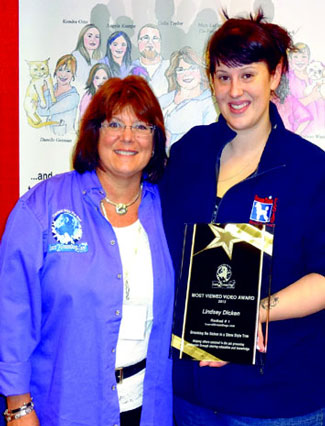
The winner of the Most Viewed Video of 2012, Lindsey Dicken, was presented her award at the Atlanta Pat Fair.
From the Archive: Our Top Ten Most Viewed Videos of 2012
The numbers have been crunched! We are thrilled to announce the Most Viewed Videos for 2012!
These videos have helped thousands of groomers to learn more about their craft. Some of our members review breed specific videos before the client’s dog arrives. While others use them to help train for competition.
But whatever the reason, here are the Top Ten Most Viewed
Videos of 2012.
Most Viewed Video – Rank #1
Grooming the Bichon in a Show Style Trim
with Lindsey Dicken
Most Viewed Video – Rank #2
Dematting Tips for Any Breed
with Karen Tucker
Most Viewed Video – Rank #3
Adorable Pet Trim on a Shih Tzu in 45 Minutes
with Suesan Watson
Most Viewed Video – Rank #4
How to Groom a Daisy Dog in Less than 45 Minutes
with Suesan Watson
Most Viewed Video – Rank #5
Trimming a Round Head Style on a Drop Coated Dog
with Melissa Verplank
Most Viewed Video – Rank #6
Grooming a Pet West Highland White Terrier
with Courtney Ramstack
Most Viewed Video – Rank #7
Trimming a Light Coated Yorkie in a Hand Scissored Trim
with Irina Pinkusevich
Most Viewed Video – Rank #8
How to Groom a Monster Sized Dog in 76 Minutes
with Lisa Leady
Most Viewed Video – Rank #9
Grooming a Bichon in a Modified Show Trim
with Lisa Leady
Most Viewed Video – Rank #10
Greatest Hits #1: Trimming Round Heads
with Suesan Watson, Misty Fowler, Marc LaFleur, Melissa Verplank
Visit our Sneak Peek Video page for links to these and other grooming lessons in our video library!
 Look in the mirror and say “I am my most valuable asset.” Tell yourself this every day! You are the most important thing about your life and your business. Despite the fact that you may think it is your car, or your favorite thinners, or even your bank account, it is YOU that is the most important part of the success equation. Without you driving the car, or using the thinners or using the money, those things are worthless.
Look in the mirror and say “I am my most valuable asset.” Tell yourself this every day! You are the most important thing about your life and your business. Despite the fact that you may think it is your car, or your favorite thinners, or even your bank account, it is YOU that is the most important part of the success equation. Without you driving the car, or using the thinners or using the money, those things are worthless.
And the part that makes you unique is your mind. Your ability to think and reason before taking action is a precious gift. And throughout life, we need to improve our thinking. The ability to improve our quality of thinking makes it easier to solve problems. Our ability to think positively lets us see opportunity around us. Negative thinking shuts doors to success.
I recently saw a report on ABC News about how our new dependency on using search engines even GPS makes us dumber? WOW! In the ‘good old days’ you used a map and directions you wrote down to get from Point A to Point B. You may have stopped when you were lost to ask for directions. Then you had to remember those directions. But now you just program a device that tells you to turn left or right. You actually lose problem solving skills as a result.
Just think of how many people struggle to figure out math problems when they don’t have a calculator.
People used to memorize phones numbers, addresses, and birthdays. Now they are stored away as reminders in our cell phones. Sure it makes things easier, but it turns our mind to mush in the process. I have read that the brain has an unlimited ability to memorize facts. So why turn that ability off?
You need to invest regularly in self-improvement and professional development. You can open your mind to knowledge by attending a seminar at a tradeshow. Or you can exchange information in online forums and places like Facebook. You can open up a copy of the AKC Complete Dog Book and memorize facts about your favorite breed. You have to exercise your brain the same as any other part of your body.
Dedicate yourself to lifelong learning. Why stop now? I continue to learn from the top professionals around me. There are always new products and new standards to talk about. Many groomers are inventing their own products. And almost all of them are happy to share their knowledge with you.
With positive thinking and lifelong learning, you can continue to find new ways to be a value to your customers. You can jump years ahead of your competition by developing new skills that are in demand. By valuing yourself as your biggest asset, you can catapult your career and life to higher levels.
 To stay on top of the grooming game, professionals need to keep learning. That’s been my motto for years. It’s always worked for me. Educational opportunities were limited 20-30 years ago. Fortunately, opportunities abound today for motivated groomers.
To stay on top of the grooming game, professionals need to keep learning. That’s been my motto for years. It’s always worked for me. Educational opportunities were limited 20-30 years ago. Fortunately, opportunities abound today for motivated groomers.
Books: More and more grooming titles are available every day. They are being written by a wide range of authors. There are grooming guides available as well and business operation manuals.
Many include stunning images to help the reader comprehend the subject matter. Some are even available via a tablet or Kindle.
Schools: What is the primary function of a school? To give their students a head start in their careers. Most schools can take months or even years off the learning process. Professional grooming schools are cropping up everywhere.
One of the best ways to learn grooming is with hands-on training. Some training centers even offer home-study options too. Either way, schools offer a structured learning environment. Programs range widely in cost, quality, course length and grooming styles.
Videos: With methods in place to honor and identify top groomers, we are seeing many of these respected stylists share their knowledge through training videos. Top professionals are creating video lessons aimed at the beginners to advanced stylists. Many lessons are on DVDs, on-line through websites or in streaming video libraries.
Internet Searches: The internet has become an indispensable tool for the groomer looking to get ahead in their career. Never seen a Portuguese Podengo? Most professional groomers haven’t – including me! A quick search via an Internet search engine will lead you down a path of enlightenment.
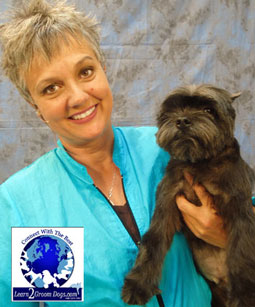
The Learn2GroomDogs.com Facebook page is a great resource for photos.
You can find breed clubs, breeders, breed history, breed standards and fabulous photos of even the most obscure breed of dog or cat. Even if you’ve never seen – or groomed a particular breed before, you can rapidly educate yourself. You’ll have the confidence – and knowledge – to talk with any owner about ‘their breed.’
Need a refresher on what a breed looks like? Jump onto the computer and do a search of Google Images. You’ll be amazed at what you can pull up. If you are looking for high quality pets, add a show title such as; ‘AKC Champion ‘ By doing this, you can filter through many of the images.
As with any internet search, you are going to find good with the bad. The more general knowledge you have about pets and grooming, the better you will be able to sort through the wealth (and garbage) typically found out on the internet.
Webinars: We are starting to see this form of learning pop up in our industry. Webinars have been around for years yet the grooming industry has been slow to embrace their power. Many technically savvy groomers are starting to share their knowledge in webinars. Some webinars are free; others charge a nominal fee to participate.
Facebook, Blogs & Online Forums: With the use of social media outlets, anyone can chat with anyone from anywhere; across the nation or around the globe. No one is worried anymore about ‘the competition.’ If you have a question, post it. If you have a fun story to share, post it.
If you need to vent (professionally please!), post it. Never before has it ever been so easy, and economical to share ideas, grooming tips and knowledge. No one should feel isolated or alone anymore. The outlets to reach out to fellow professionals are simply remarkable via the World Wide Web.
Seminars: You’ll find seminars every grooming trade show around the country. You will also find privately held seminars too. You’ll find these private seminars hosted by; distributors, product manufactures, grooming schools, grooming salons or even the professional themselves. These seminars area a great place to get your questions answered about any aspect of the grooming
profession.
Private Coaching & Clinics: Need a tutor? Need a coach? One of the best ways to perfect a skill or a trim style is with personal, hands-on assistance. Many of the top stylists are available to help you privately or in a smaller group setting. Many are well rounded in many aspects of the grooming industry. Others will specialize in trim styles, grooming techniques, sales and marketing or business operations. Many will travel great distances to set up coaching sessions.
Find a business professional you admire. Contact them and ask if they offer private lessons. Many do or they host small clinics where you can all share the cost of the session.
Trade Shows: Going to a grooming show is still one of the most refreshing ways to learn. Most trade shows have a wide variety of vendors there too so you can speak directly to the sales representative about a product or service they offer. Sit ringside at a grooming competition.
You’ll be blown away at the style and trim quality being found with high level pet stylist. Trade show promoters are always seeking out a wide variety of speakers and topics to present at their shows. Can’t get to a show? Some of the larger shows and grooming competitions are now available via streaming video on the internet.
I remember being in Croatia on a sailboat a few years back. I was able to watch the World Team Grooming Competition right from my laptop as the competition took place in Belgium. Very exciting!
Certification Programs: We are seeing more and more certification program become available whether it is for dog grooming, cat grooming, pet first aid or business management. At this point, most programs are voluntary but all are worth their weight in gold. Some of the programs can be completed in a day or a weekend. Others will take months, or even years of study and testing before successfully completing the full program. A few of the programs even have Apps set up for your technical device.
Education, skill enhancement and effective communication are the keys to a successful career. Never underestimate their importance. One of the greatest inspirations in any career is continued growth. Learning is the key to everlasting success. With learning trends today, it’s never been easier! Never stop learning.
When looking at learning opportunities, I always encourage you to research the quality of the material, the program or the lesson. You will only increase your knowledge if the information being shared or taught is from a true professional. A professional that has years of expertise and a resume to back it up!